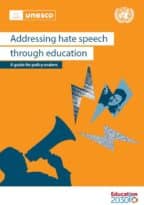Fonte:
UNESCO
Autore:
UNESCO
“Addressing Hate Speech Through Education”
How can countries worldwide tap into the power of education to counter hate speech online and offline? UNESCO and the United Nations Office on Genocide Prevention and the Responsibility to Protect (UNOSAPG) have jointly developed the first guide for policy-makers and teachers to explore educational responses to this phenomenon and give practical recommendations for strengthening education systems. The guide is part of the implementation of the UN Strategy and Plan of Action on Hate Speech. Here’s a glimpse into some of the main ideas of this new tool.
Where do we draw the line between hate speech and free speech?
Hate speech violates the fundamental human rights of the people that are targeted. Opinions may offend, shock or disturb, but they cannot incite violence, hostility and discrimination. In and through education, learners discover how to draw the line between insults and hate speech, as well as understand the consequences and impact of their words and actions on other people. Discouraging the spread of hateful narratives doesn’t impede learners’ freedom of speech nor the expression of their opinions. On the contrary, education can help uphold this fundamental right by promoting respect, mutual understanding, and a shared sense of humanity.
What’s the role of media and information literacy?
In the “attention economy”, hate speech narratives are the ones that often seduce the most, offering an easily achievable sense of community and maximized reach of such messages. Learners need to be empowered to understand the mechanisms underpinning the functioning of media and digital platforms and spot the persuasive tactics commonly used to spread conspiracy theories and other forms of disinformation and harmful content. Evidence shows that developing media and information literacy skills makes them less prone to exclusionary and violent extremist ideas. Teachers, in turn, benefit from these discussions to better understand and reflect on learners’ experiences from the digital world, where hateful content is virulent as never before.
What are ways to spot and counter hateful narratives within curricula?
One-sided narratives that fuel hate speech and justify exclusion can be found across different subjects and educational programmes. Discussing these narratives with school students and acknowledging their problematic nature is integral to the solution. This includes facilitating uncomfortable conversations about social inequality and power dynamics, decoding and debunking stereotypes and prejudice, and addressing the trauma and stigmatization caused by violent pasts. Teaching and learning about these issues and revising and reviewing curricula and educational materials can sensitize learners to contemporary forms of discrimination and increase their understanding of the processes that lead societies to violence.
How can teachers create an alternative sense of belonging?
To complement curricular interventions, a safe, caring, inclusive, and collaborative classroom climate is necessary. Hate can give a sense of purpose and belonging. It is, therefore, crucial to invest in building a sense of community in and out of schools and integrate missing perspectives in the education process. Programmes that support global citizenship education and promote collaborative, culturally responsive and inclusive practices can help to develop the necessary knowledge and competence to embrace differences and engage respectfully in a diverse society. Social and emotional learning (SEL) provides practical tools and techniques that teachers can help use to foster a sense of belonging amongst learners. By using case studies and real-life scenarios to discuss controversial situations and different points of view, learners are able to manage stress and negative emotions, acknowledge their strengths and weaknesses, and resolve conflicts.
What does a comprehensive approach look live?
To effectively counter hate speech online and offline and foster a safe and inclusive environment free from all forms of hatred and discrimination, efforts made by educators in the classroom must be reflected in all aspects of school life, including policies, extracurricular activities, sports, and social and cultural events. Active engagement of teachers, administration, and parents is a critical success determinant. The private sector has a role to play, too. Internet companies can contribute by devoting time and resources in risk assessment mechanisms as well as independent audits of the automated tools that enable the amplification of hate speech. They should consider involving victims, civil society and/or intergovernmental organisations in these processes and in the evaluation of the application of their terms of services. Investment in educational tools that enable users to recognise and respond to disinformation is also among the measures that could be taken to address hate speech.
What efforts are needed to address and counter hate speech more effectively?
A comprehensive response with a whole-of-society approach is essential, with the following vital areas of action to consider:
- Establishing the need to combat hate speech as a matter of national and global priority at the highest political levels,
- Addressing hate speech in the content of education programmes/curricula and pedagogical approaches at every level of formal, non-formal and informal education, from early childhood through higher education to lifelong learning,
- Putting in place effective anti-discrimination policies and strategies,
- Developing better reporting mechanisms at the local, national and global levels,
- Coordinating improved responses with social media companies,
- Encouraging further research on the nature and spread of hate speech and the effectiveness of the responses and mitigation measures implemented by various stakeholders, including in the education sector.


